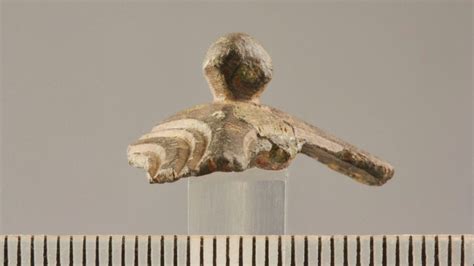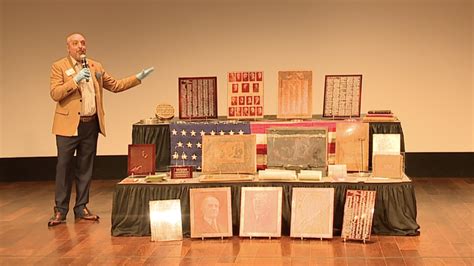
A remarkably well-preserved, 1,600-year-old Roman artifact, identified as a decorated leather shoe, has been unearthed by archaeologists in Germany, offering a rare glimpse into daily life during the late Roman Empire. The discovery, hailed as a “real time capsule,” showcases the advanced craftsmanship and intricate designs prevalent in Roman footwear of the era.
The shoe, found at a Roman fort in Bavaria, provides invaluable insights into the personal attire and socio-economic conditions of Roman soldiers and civilians who inhabited the region centuries ago. The exceptional preservation of the leather, attributed to the specific soil conditions at the site, has allowed researchers to examine the shoe’s construction and decorative elements in stunning detail.
“The find is really a stroke of luck,” stated the Bavarian State Office for the Preservation of Monuments, highlighting the significance of the discovery. “The leather and the shoelaces have been preserved.” The statement underscored the rarity of finding organic materials in such an advanced state of conservation after centuries underground.
The archaeological site, located in the Bavarian town of Flavia Solva, was once a prominent Roman settlement. Excavations at the site have consistently yielded significant artifacts, shedding light on the Roman presence in the region and the interactions between Roman and indigenous populations.
The shoe is not merely a utilitarian object; it is a testament to the artistry and cultural sophistication of the Roman Empire. The decorative elements on the shoe, including intricate patterns and embellishments, suggest that it was not a standard-issue item but rather a personalized piece of footwear, possibly belonging to a high-ranking officer or a wealthy civilian.
The discovery of the Roman shoe has generated considerable excitement among archaeologists and historians, who view it as a unique opportunity to study Roman material culture and gain a deeper understanding of daily life in the Roman provinces. The artifact is expected to provide valuable data for comparative studies of Roman footwear and clothing from other parts of the empire, offering insights into regional variations and trade networks.
The Bavarian State Office for the Preservation of Monuments plans to conduct further research on the shoe, including detailed analysis of the leather and decorative elements. The artifact will be carefully preserved and eventually displayed in a museum, allowing the public to appreciate its historical and cultural significance.
The find underscores the importance of archaeological research in uncovering and preserving the material remains of past civilizations, offering tangible connections to our shared human history. The Roman shoe serves as a poignant reminder of the people who lived and worked in the Roman Empire, their aspirations, and their contributions to the development of European culture.
The excavation site itself is part of a larger effort to understand Roman settlements along the Danube River, which served as a crucial frontier of the Roman Empire. These settlements played a vital role in defense, trade, and cultural exchange, shaping the political and economic landscape of the region for centuries.
The Roman Empire’s influence extended far beyond its military conquests, leaving an indelible mark on European law, language, architecture, and engineering. Archaeological discoveries like the Roman shoe provide concrete evidence of this influence and help to illuminate the complexities of Roman society.
The preservation of organic materials like leather is particularly challenging for archaeologists, as these materials are susceptible to decomposition over time. The favorable soil conditions at the Bavarian site, characterized by low oxygen levels and consistent moisture, created an environment that inhibited the decay process.
The analysis of the shoe’s construction techniques and materials will provide valuable information about Roman manufacturing processes and trade networks. Researchers will be able to identify the types of leather used, the methods of tanning and dyeing, and the tools and techniques employed by Roman shoemakers.
The decorative elements on the shoe may also offer clues about the wearer’s social status and personal preferences. The patterns and embellishments could have had symbolic meanings or reflected regional styles, providing insights into the cultural identity of the individual.
The discovery of the Roman shoe is a testament to the enduring legacy of the Roman Empire and the power of archaeology to reveal the secrets of the past. The artifact will serve as a valuable resource for researchers and educators, helping to bring Roman history to life for future generations.
Further excavations at the site are planned, with the hope of uncovering additional artifacts and expanding our understanding of the Roman settlement. The Bavarian State Office for the Preservation of Monuments is committed to protecting and preserving the archaeological heritage of the region, ensuring that these invaluable resources are available for study and appreciation for years to come.
The meticulous work of the archaeologists involved in the excavation is essential for ensuring that artifacts like the Roman shoe are properly documented and preserved. Their expertise in excavation techniques, artifact analysis, and conservation methods is crucial for unlocking the secrets of the past and sharing them with the world.
The Roman shoe is not just an object; it is a window into the past, offering a glimpse into the lives of the people who lived and worked in the Roman Empire. It is a reminder of the enduring power of human creativity and the importance of preserving our shared cultural heritage.
Expanded Details and Context:
The Bavarian site where the shoe was discovered, Flavia Solva, stands as a testament to the Roman presence in what is now modern-day Germany. The Roman Empire, at its zenith, extended its reach far beyond the Italian peninsula, incorporating vast territories across Europe, North Africa, and the Middle East. These provinces were not merely conquered lands but were integrated into the Roman system of governance, trade, and culture.
Flavia Solva, like other Roman settlements in the region, served as a strategic outpost, a center of economic activity, and a conduit for the dissemination of Roman culture. The Roman army played a crucial role in maintaining order and defending the frontier against incursions from Germanic tribes. Roman forts and garrisons were established along the Danube River, providing a network of defense and communication.
The civilian population of Flavia Solva consisted of Roman citizens, merchants, artisans, and local inhabitants who had adopted Roman customs and practices. The town boasted a forum, temples, bathhouses, and other public buildings, reflecting the Roman emphasis on urban planning and infrastructure.
The discovery of the Roman shoe provides valuable insights into the material culture of Flavia Solva. The shoe itself is a testament to the skills of Roman artisans and the availability of resources within the province. The leather used to make the shoe was likely sourced locally, and the tanning and dyeing processes would have been carried out by skilled craftsmen.
The decorative elements on the shoe suggest that it was a personalized item, possibly belonging to a member of the elite. Roman society was highly stratified, with distinct social classes and hierarchies. Clothing and footwear were often used to signify social status and wealth.
The preservation of the shoe is particularly remarkable, given the fragility of organic materials. The soil conditions at the site, characterized by low oxygen levels and consistent moisture, created an anaerobic environment that inhibited the growth of microorganisms that cause decomposition.
The Bavarian State Office for the Preservation of Monuments plays a crucial role in protecting and preserving the archaeological heritage of the region. The office conducts archaeological excavations, analyzes artifacts, and works to ensure that historical sites are properly managed and protected.
The discovery of the Roman shoe is a reminder of the importance of archaeological research in uncovering and interpreting the material remains of the past. Archaeology provides a tangible connection to our ancestors and helps us to understand the complexities of human history.
The Roman Empire’s legacy continues to shape European culture and society. Roman law, language, architecture, and engineering have all had a profound influence on the development of the continent. Archaeological discoveries like the Roman shoe provide concrete evidence of this influence and help us to appreciate the enduring power of the Roman Empire.
The analysis of the shoe will involve a range of scientific techniques, including radiocarbon dating, microscopy, and chemical analysis. Radiocarbon dating will help to determine the precise age of the shoe, while microscopy will allow researchers to examine the structure of the leather and the decorative elements in detail. Chemical analysis will provide information about the types of materials used to make the shoe and the processes used to tan and dye the leather.
The information gleaned from the analysis of the shoe will be compared to findings from other Roman sites across Europe, allowing researchers to build a more comprehensive picture of Roman material culture and trade networks. The study of Roman footwear can provide insights into the styles, materials, and manufacturing techniques used in different regions of the empire.
The discovery of the Roman shoe has generated considerable public interest, highlighting the enduring fascination with the Roman Empire and the power of archaeology to reveal the secrets of the past. The Bavarian State Office for the Preservation of Monuments plans to display the shoe in a museum, allowing the public to appreciate its historical and cultural significance.
The excavation at Flavia Solva is ongoing, and archaeologists hope to uncover additional artifacts that will shed further light on the Roman settlement. The site has the potential to yield valuable information about the daily lives of the people who lived and worked in the Roman Empire.
The Roman shoe is a tangible link to the past, a reminder of the human stories that are embedded in the archaeological record. It is a testament to the ingenuity and craftsmanship of Roman artisans and the enduring legacy of the Roman Empire.
Further Analysis:
The remarkable preservation of the 1,600-year-old Roman shoe offers an unparalleled opportunity for researchers to delve into the nuances of Roman craftsmanship, social stratification, and daily life along the empire’s frontier. While the discovery itself is significant, the detailed analysis that follows will unlock even more profound insights.
Material Composition and Manufacturing Techniques:
The composition of the leather itself will be a focal point of analysis. Determining the animal species from which the leather was derived can provide clues about local animal husbandry practices and trade routes. Microscopic examination will reveal the tanning techniques employed, offering insights into the chemical processes used to preserve and treat the leather. Different tanning methods, such as vegetable tanning (using tannins from tree bark) or mineral tanning (using alum or other minerals), would have resulted in different properties and appearances of the leather.
Furthermore, the stitching and construction methods used to assemble the shoe will be meticulously studied. The type of thread used, the stitch patterns, and the overall design of the shoe can be compared to other known examples of Roman footwear to identify regional variations and potential workshops or production centers. Any evidence of repairs or alterations to the shoe can also shed light on its lifespan and the wearer’s economic circumstances.
Decoration and Social Significance:
The decorative elements on the shoe are particularly intriguing. The patterns, motifs, and embellishments can provide clues about the wearer’s social status, personal preferences, and cultural affiliations. Were the decorations purely ornamental, or did they carry symbolic meanings? Were they common designs, or were they unique and indicative of a higher social standing?
Comparison to other Roman artifacts, such as mosaics, frescoes, and pottery, may reveal parallels in decorative styles and motifs. This could provide further evidence of the shoe’s cultural context and its connection to broader trends in Roman art and fashion.
It’s important to consider that in Roman society, clothing and accessories were often used to express identity and status. The quality of the materials, the craftsmanship, and the presence of decorative elements all contributed to the overall impression conveyed by an individual’s attire.
Environmental Context and Preservation:
The exceptional preservation of the shoe is a result of the specific environmental conditions at the Flavia Solva site. The soil’s low oxygen levels and consistent moisture created an anaerobic environment that inhibited the growth of microorganisms responsible for decomposition. However, even in such favorable conditions, the leather would have undergone some degree of degradation over time.
Researchers will use a variety of techniques to assess the extent of this degradation and to develop strategies for long-term preservation. This may involve the use of consolidants, which are chemicals that strengthen the leather and prevent further deterioration. The shoe will also need to be stored in a controlled environment with stable temperature and humidity levels to minimize the risk of damage.
Comparative Analysis:
The true value of the Roman shoe lies not only in its individual characteristics but also in its potential to contribute to a broader understanding of Roman footwear and material culture. By comparing the Flavia Solva shoe to other examples found at Roman sites across Europe and beyond, researchers can identify regional variations, track the evolution of footwear styles, and gain insights into trade networks and cultural exchange.
For example, Roman military boots (caligae) are relatively well-documented, but civilian footwear is less common in the archaeological record. The Flavia Solva shoe could provide a valuable point of comparison for understanding the differences between military and civilian attire, and for shedding light on the daily lives of ordinary Romans.
The Broader Significance:
The discovery of the Roman shoe is a reminder of the importance of preserving and studying the material remains of the past. These artifacts offer tangible connections to our ancestors and provide insights into their lives, their beliefs, and their accomplishments. By understanding the past, we can gain a better appreciation of the present and a clearer vision for the future.
The Flavia Solva site, with its rich archaeological heritage, has the potential to yield many more discoveries in the years to come. Continued excavation and research will undoubtedly shed further light on the Roman presence in the region and the complex interactions between Roman and indigenous cultures.
The Roman shoe is not merely an object; it is a story waiting to be told. Through careful analysis and interpretation, researchers can unlock its secrets and share them with the world, enriching our understanding of Roman history and culture.
FAQ (Frequently Asked Questions):
1. What exactly was found?
Archaeologists discovered a remarkably well-preserved, 1,600-year-old Roman leather shoe at a Roman fort site in Bavaria, Germany. The “Bavarian State Office for the Preservation of Monuments” described the find as “a stroke of luck,” noting the preservation of both the leather and shoelaces.
2. Where was the shoe found, and why is that location important?
The shoe was found in Flavia Solva, Bavaria, a significant Roman settlement along the Danube River, which served as a crucial frontier of the Roman Empire. This location is important because it offers insights into Roman life in a provincial setting, showcasing interactions between Roman and indigenous populations, as well as military and civilian aspects of the empire.
3. How well-preserved is the shoe, and why is that significant?
The shoe is exceptionally well-preserved, with both the leather and shoelaces remaining intact after 1,600 years. This is significant because organic materials like leather rarely survive for such long periods, offering archaeologists a unique opportunity to study Roman craftsmanship, materials, and potentially gain insights into the wearer’s social status. The “Bavarian State Office for the Preservation of Monuments” emphasized the rarity of such well-preserved organic material.
4. What might this shoe tell us about Roman life?
The shoe can provide insights into Roman footwear styles, manufacturing techniques, trade networks (depending on the leather’s origin), and the wearer’s potential social status based on the shoe’s quality and decoration. It also contributes to our understanding of daily life in a Roman settlement along a crucial frontier. The intricate details and patterns could reveal more about the cultural identity and personal preferences of the individual who wore it.
5. What are the next steps for the artifact?
The Bavarian State Office for the Preservation of Monuments plans further research on the shoe, including detailed analysis of the leather and decorative elements. It will be carefully preserved and eventually displayed in a museum, allowing the public to appreciate its historical and cultural significance. This includes radiocarbon dating, microscopy, and chemical analysis.









